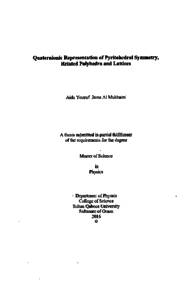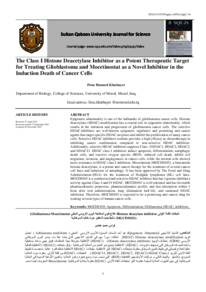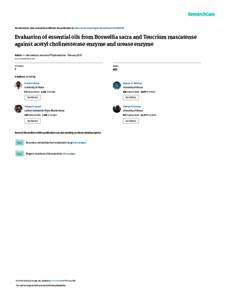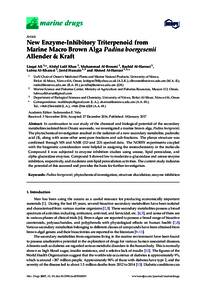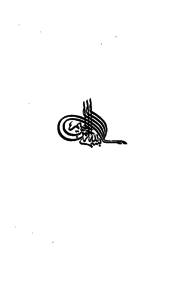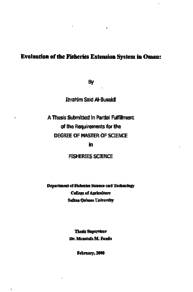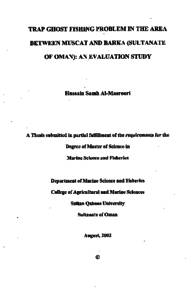Document
Optimization and production of alkaline protease using fish waste as substerate
Publisher
Sultan Qaboos University
Gregorian
2016
Language
English
Subject
English abstract
Proteases are protein hydrolysing enzymes. More than 60% of the industrial enzymes are proteases with a wide range of applications. Thermostable bacteria are capable of producing thermostable proteases that can resist denaturation due to extreme temperature, pH and chemicals. The guts from Sardinella longiceps were processed and used as substrate for low cost production of protease enzyme. Fish waste contained 61.6 % proteins, 21.8% lipids, 8.5% carbohydrates and trace elements such as K, Na+, Ca2+, Mg2+, Fe2+, Zn*, P3- and salts PO4, C12, SO42- and NO3. Soil samples were collected from Nakhi hot spring in Sultanate of Oman to isolate protease producing bacteria. From 101 isolates, one bacteria that produced the highest protease activity (51.8 U/ml) was identified as Bacillus licheniformis. The protease enzyme produced under optimized conditions was purified and characterized. Optimization of protease. production conditions was carried out using Placket Burman (PB) design and Response Surface Methodology (RSM). Positive factors for protease fermentation were studied using PB design with 13 runs using combinations of five factors. The factor ranges were temperature (40-80°C), pH (7-12), time (24-72 h), substrate concentration (0.5-2%), and inoculum size (1-5%). Based on PB results, factors and levels for RSM design were selected. The factors and levels were temperature (40 50°C), time (65-75 h), substrate concentration (1.5-3%), and inoculum size (4-5%) and the design generated 31 runs with different combinations. Model was significant (R2 – 82.92%) and production under optimized conditions produced an increase of 1.5-fold in activity resulting in 73.52 U/ml. Purified enzyme produced a final yield of 1.70% with a 6.46-fold purification. Molecular weight of the enzyme was determined by SDS-PAGE as 60 and 65 KDa with two corresponding bands. The purified protease was characterized as alkaline and thermo tolerant protease with its optimum pH at 9 and temperature at 50°C. Protease activity was enhanced by Zn++ and Nat and was inhibited by other metal ions. Protease was stable against urea, B-mercaptoethanol, sodium dodecyl sulphate (SDS) and tween 80. Protease enzyme was compatible with four commercial detergents such as Arial, Bahar, Bonux and Tide and the best substrate for maximum activity was tryptone soya. The protease had a maximum velocity of 88.57 U/ml and Km equivalent to 0.4384 mg/ml. Thus, the fish waste could be used as a cheaper substrate for protease production and the Nakhl hot spring is a good source for isolating bacteria with biotechnological potentials..
Description
Thesis
Member of
Resource URL
Arabic abstract
الخلاصة
الانزيم البروتيني (Protease) عبارة عن بروتين ينتمي للأنزيمات المحللة حيث أنه يمثل أكثر من 60% من الانزيمات الصناعية مع مجموعة واسعة من التطبيقات، فالبكتيريا المقاومة للحرارة قادرة على انتاج الأنزيم البروتيني مقاوم للحرارة لذلك يكون قادر على مقاومة التشوه الذي تسببه درجات الحرارة العالية ، ودرجة الحموضة والمواد الكيميائية والإنتاج هذا الانزيم بتكلفة منخفضة فقد تم تحضير أحشاء سمك السردين (Sardinella longiceps) واستخدامه كركيزة أساسية في عملية الانتاج ، وتحتوي نفايات الأسماك على %61.6بروتينات، .8%21 . 8 % دهون، و .5%8 من الكربوهيدرات ومجموعة من العناصر النادرة مثل *K و *Na ,p3 .,Fe2,Mg2Ca2و بعض الأملاح مثل - SO42,C12
PO4و -NO3 ، تم جمع عينات التربة من عين الثوارة الحارة بولاية نخل (سلطنة عمان لعزل البكتيريا المنتجة لهذا البروتين فقد تم عزل عدد 101بكتيريا بينما بكتيريا واحده انتجت أعلى نشاط للأنزيم البروتيني قدره (51.8U/ml) وتعرف باسم (Bacillus licheniformis) وتم إنتاج الإنزيم البروتيني تحت ظروف مثالية وبعد ذلك تم تنقيته وتمييز خواصه، وجرى تحسين ظروف الانتاج باستخدام نموذج (Placket Burman ( PB) Response Surfaceو ثم تم دراسة العوامل المؤثرة على عملية لهذا التخمير الإنزيم باستخدام تصميم PB حيث تم اجراء التجربة 13 مرة باستخدام مزيج من العوامل الخمسة، وكانت مدى عامل درجة الحرارة (40-80 درجة مئوية)، ودرجة الحموضة (7-12)، والوقت (24-72 ساعة)، وتركيز الركيزة (. 5-2٪)، ونسبة البكتيريا المضافة (1-5٪) ، وبناء على نتائج PB فقد تم اختيار العوامل والمستويات لنموذج RSM وكانت العوامل كالتالي: درجات الحرارة (40-50 درجة مئوية)، الوقت (65-75 ساعة)، تركيز الركيزة . 5-3٪)1(، و نسبة البكتيريا المضافة (4-5٪) وانتج التصميم 31 مرة من مزيج من العوامل المختلفة، وأظهرت النتائج فعالية كبيره للنموذج ((R=82.92%، و اظهرت عملية الانتاج في ظل الظروف المثالية زيادة قدرها 5. اضعف في النشاط ما يعادل u/ml73.52 أما بالنسبة لإنتاج إنزيم نقي فقد كان العائد النهائي 1.70%
. مع تنقية .466 ضعف ، بعدها تم تحديد الوزن الجزيئي للأنزيم بواسطة SDS
- PAGEحيث كان مقداره 60 و 65 كيلو دالتون واتسم البروتين المنقى بتحمله للقواعد والحرارة حيث أن الرقم الهيدروجيني الأمثل هو 9 ودرجة الحرارة عند 50 درجة مئوية وتم تعزيز نشاط الأنزيم البروتيني بواسطة الزنك والصوديوم أما الأيونات المعدنية الأخرى فكان تأثيرها سلبيا، حيث كان الانزيم البروتيني مستقر في وجود اليوريا وبيتا مركابتوريثانول و (SDS) وتوین 80. وقد أوضحت النتائج أن الإنزيم البروتيني كان متوافقا مع أربعة منظفات تجارية مثل صابون ایریل وبحر وبونكس وتاید وافضل الركيزة الأقصى قدر من النشاط وكان بوجود تريبتون الصويا، حيث كانت سرعة الانزيم البروتيني القصوى منu/ml .5788 وقيمة ثابت Km عادل . 4384 mg / mlوختاما فانه يمكن أن تستخدم نفايات الأسماك باعتبارها ركيزة أرخص لإنتاج الأنزيم البروتيني وعين الثوارة الحارة كمصدر جيد لعزل البكتيريا ذات إمكانيات تكنولوجيا حيوية
الانزيم البروتيني (Protease) عبارة عن بروتين ينتمي للأنزيمات المحللة حيث أنه يمثل أكثر من 60% من الانزيمات الصناعية مع مجموعة واسعة من التطبيقات، فالبكتيريا المقاومة للحرارة قادرة على انتاج الأنزيم البروتيني مقاوم للحرارة لذلك يكون قادر على مقاومة التشوه الذي تسببه درجات الحرارة العالية ، ودرجة الحموضة والمواد الكيميائية والإنتاج هذا الانزيم بتكلفة منخفضة فقد تم تحضير أحشاء سمك السردين (Sardinella longiceps) واستخدامه كركيزة أساسية في عملية الانتاج ، وتحتوي نفايات الأسماك على %61.6بروتينات، .8%21 . 8 % دهون، و .5%8 من الكربوهيدرات ومجموعة من العناصر النادرة مثل *K و *Na ,p3 .,Fe2,Mg2Ca2و بعض الأملاح مثل - SO42,C12
PO4و -NO3 ، تم جمع عينات التربة من عين الثوارة الحارة بولاية نخل (سلطنة عمان لعزل البكتيريا المنتجة لهذا البروتين فقد تم عزل عدد 101بكتيريا بينما بكتيريا واحده انتجت أعلى نشاط للأنزيم البروتيني قدره (51.8U/ml) وتعرف باسم (Bacillus licheniformis) وتم إنتاج الإنزيم البروتيني تحت ظروف مثالية وبعد ذلك تم تنقيته وتمييز خواصه، وجرى تحسين ظروف الانتاج باستخدام نموذج (Placket Burman ( PB) Response Surfaceو ثم تم دراسة العوامل المؤثرة على عملية لهذا التخمير الإنزيم باستخدام تصميم PB حيث تم اجراء التجربة 13 مرة باستخدام مزيج من العوامل الخمسة، وكانت مدى عامل درجة الحرارة (40-80 درجة مئوية)، ودرجة الحموضة (7-12)، والوقت (24-72 ساعة)، وتركيز الركيزة (. 5-2٪)، ونسبة البكتيريا المضافة (1-5٪) ، وبناء على نتائج PB فقد تم اختيار العوامل والمستويات لنموذج RSM وكانت العوامل كالتالي: درجات الحرارة (40-50 درجة مئوية)، الوقت (65-75 ساعة)، تركيز الركيزة . 5-3٪)1(، و نسبة البكتيريا المضافة (4-5٪) وانتج التصميم 31 مرة من مزيج من العوامل المختلفة، وأظهرت النتائج فعالية كبيره للنموذج ((R=82.92%، و اظهرت عملية الانتاج في ظل الظروف المثالية زيادة قدرها 5. اضعف في النشاط ما يعادل u/ml73.52 أما بالنسبة لإنتاج إنزيم نقي فقد كان العائد النهائي 1.70%
. مع تنقية .466 ضعف ، بعدها تم تحديد الوزن الجزيئي للأنزيم بواسطة SDS
- PAGEحيث كان مقداره 60 و 65 كيلو دالتون واتسم البروتين المنقى بتحمله للقواعد والحرارة حيث أن الرقم الهيدروجيني الأمثل هو 9 ودرجة الحرارة عند 50 درجة مئوية وتم تعزيز نشاط الأنزيم البروتيني بواسطة الزنك والصوديوم أما الأيونات المعدنية الأخرى فكان تأثيرها سلبيا، حيث كان الانزيم البروتيني مستقر في وجود اليوريا وبيتا مركابتوريثانول و (SDS) وتوین 80. وقد أوضحت النتائج أن الإنزيم البروتيني كان متوافقا مع أربعة منظفات تجارية مثل صابون ایریل وبحر وبونكس وتاید وافضل الركيزة الأقصى قدر من النشاط وكان بوجود تريبتون الصويا، حيث كانت سرعة الانزيم البروتيني القصوى منu/ml .5788 وقيمة ثابت Km عادل . 4384 mg / mlوختاما فانه يمكن أن تستخدم نفايات الأسماك باعتبارها ركيزة أرخص لإنتاج الأنزيم البروتيني وعين الثوارة الحارة كمصدر جيد لعزل البكتيريا ذات إمكانيات تكنولوجيا حيوية
Category
Theses and Dissertations

